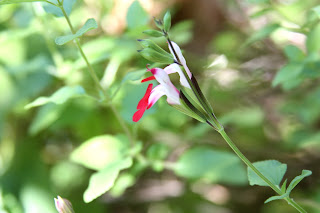Hot Lips Sage is Salvia microphylla Hot Lips
Plant Delights Nursery offers them in their online catalog at www.plantdelights.com. The catalog says it "was
introduced by Richard Turner of California after the plant was shared with him
by his maid, who brought it from her home in Mexico.
The fast-growing, 30" tall
x 6' wide clump is adorned with stunning bicolor flowers with red tips and white
lips...attractive to hummingbirds. When the nights warm in summer, the new
flowers are all red with an occasional solid white one. As fall approaches, the
flowers again will be bicolored red and white."
Phagat.com says it was developed at the San Francisco Arboretum. Their take on the story of origin is, "Richard Turner, editor of Pacific Horticulture Magazine, threw a house
warming party, for which his Mexican maid Alta-Gracia provided flowers from her
personal garden, including a certain salvia from Oaxaca, Mexico, which none of
Alta-Gracia's boss's horticultural buddies had ever seen before. Overlooking for
the moment the abominable cliche of rich honkies with their Latina servants, we
may count it lucky her name is reported at all, even without last name."
Phagat recommends a hard prune in late winter in temperate areas such as Washington state.
Phagat recommends a hard prune in late winter in temperate areas such as Washington state.
You can propagate Hot Lips like other woody Salvias, by taking cuttings and layering. I have had luck taking cuttings of Salvia Elegans, Pineapple Sage (http://www.mountainvalleygrowers.com/salelegans.htm), to make more plants.
Layering is so easy though, maybe I'll do that this year.




Comments